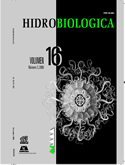Use of constructed wetlands for the treatment of water from an experimental channel at Xochimilco, Mexico
Palabras clave:
Chinampas, constructed wetlands, Lemna gibba, Scirpus americanus, nutrient removal.Resumen
Two constructed wetlands were designed and their performance in the treatment of water from Cuemanco, in an experimental channel at Xochimilco, Mexico was assessed. One of them employed emergent macrophytes (Scirpus americanus) and the other one used floating macrophytes (the duckweed Lemna gibba). The system was stabilized for five months. Water quality was improved after 220 days of treatment, as organic matter (assessed as DQO) was removed from 43.38% to 58.52% by employing L. gibba and S. americanus, respectively. Nutrient removal significatively (P < 0.05) differed between the two treatments and the control, as 86.35% and 80.33% of ammonia, 89.47% and 90.23% of nitrite, and 38.44% and 50.20% of reactive phosphorus were removed by S. americanus and L. gibba, respectively. On the other hand, water pH changed from alkaline values to neutrality after the treatment, an important issue as this water is employed for cultured land irrigation.Descargas
Descargas
Publicado
Cómo citar
Número
Sección
Licencia
Los autores/as que publiquen en esta revista aceptan las siguientes condiciones:
De acuerdo con la legislación de derechos de autor, HIDROBIOLÓGICA reconoce y respeta el derecho moral de los autores, así como la titularidad del derecho patrimonial, el cual será cedido a la revista para su difusión en acceso abierto.
Publicar en la revista HIDROBIOLÓGICA tiene un costo de recuperación de $500 pesos mexicanos por página en blanco y negro (aproximadamente 29 dólares americanos) y $1000 pesos por página a color (aproximadamente 58 dólares americanos).
Todos los textos publicados por HIDROBIOLÓGICA sin excepción se distribuyen amparados bajo la licencia Creative Commons 4.0Atribución-No Comercial (CC BY-NC 4.0 Internacional), que permite a terceros utilizar lo publicado siempre que mencionen la autoría del trabajo y a la primera publicación en esta revista.
Los autores/as pueden realizar otros acuerdos contractuales independientes y adicionales para la distribución no exclusiva de la versión del artículo publicado en HIDROBIOLÓGICA (por ejemplo incluirlo en un repositorio institucional o publicarlo en un libro) siempre que indiquen claramente que el trabajo se publicó por primera vez en HIDROBIOLÓGICA.
Para todo lo anterior, el o los autor(es) deben remitir el formato de Carta-Cesión de la Propiedad de los Derechos de la primera publicación debidamente requisitado y firmado por el autor(es). Este formato se puede enviar por correo electrónico en archivo pdf al correo: enlacerebvistahidrobiológica@gmail.com; rehb@xanum.uam.mx (Carta-Cesión de Propiedad de Derechos de Autor).
Esta obra está bajo una licencia de Creative Commons Reconocimiento-No Comercial 4.0 Internacional.


